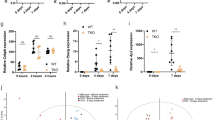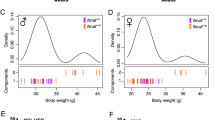Abstract
Genetic studies have shown that mutations within the mahogany locus1 suppress the pleiotropic phenotypes, including obesity, of the agouti-lethal-yellow mutant2,3. Here we identify the mahogany gene and its product; this study, to our knowledge, represents the first positional cloning of a suppressor gene in the mouse. Expression of the mahogany gene is broad; however, in situ hybridization analysis emphasizes the importance of its expression in the ventromedial hypothalamic nucleus, a region that is intimately involved in the regulation of body weight and feeding. We present new genetic studies that indicate that the mahogany locus does not suppress the obese phenotype of the melanocortin-4-receptor null allele4 or those of the monogenic obese models (Lepdb, tub and Cpefat). However, mahogany can suppress diet-induced obesity, the mechanism of which is likely to have implications for therapeutic intervention in common human obesity. The amino-acid sequence of the mahogany protein suggests that it is a large, single-transmembrane-domain receptor-like molecule, with a short cytoplasmic tail containing a site that is conserved between Caenorhabditis elegans and mammals. We propose two potential, alternative modes of action for mahogany: one draws parallels with the mechanism of action of low-affinity proteoglycan receptors such as fibroblast growth factor and transforming growth factor-β, and the other suggests that mahogany itself is a signalling receptor.
This is a preview of subscription content, access via your institution
Access options
Subscribe to this journal
Receive 51 print issues and online access
$199.00 per year
only $3.90 per issue
Buy this article
- Purchase on Springer Link
- Instant access to full article PDF
Prices may be subject to local taxes which are calculated during checkout





Similar content being viewed by others
References
Lane, P. W. & Green, M. C. Mahogany, a recessive color mutation in linkage group V of the mouse. J.Hered. 51, 228–230 (1960).
Miller, K. A. et al. Genetic studies of the mouse mutations mahogany and mahoganoid. Genetics 146, 1407–1415 (1997).
Dinulescu, D. M. et al. Mahogany (mg) stimulates feeding and increases basal metabolic rate independent of its suppression of agouti. Proc. Natl Acad. Sci. USA 95, 12707–12712 (1998).
Huszar, D. H. et al. Targeted disruption of the melanocortin-4 receptor results in obesity in mice. Cell 88, 131–141 (1997).
Lu, et al. Agouti protein is an antagonist of the melanocyte-stimulating hormone receptor. Nature 371, 799–802 (1994).
Yang, Y. K. et al. Effects of recombinant agouti-signaling protein on melanocortin action. Mol. Endocrinol. 11, 274–280 (1997).
Robbins, L. S. et al. Pigmentation phenotypes of variant extension locus alleles result from point mutations that alter MSH receptor function. Cell 72, 827–834 (1993).
Mountjoy, K. G., Mortrud, M. T., Low, M. J., Simerly, R. B. & Cone, R. D. Localization of the melanocortin-4 receptor (MC4-R) in neuroendocrine and autonomic control circuits in the brain. Mol. Endocrinol. 8, 1298–1308 (1994).
Schultz, J., Milpetz, F., Bork, & Ponting, C. P. SMART, a simple modular architecture research tool: identification of signaling domains. Proc. Natl Acad. Sci. USA 95, 5857–5864 (1998).
Nakayama, M. et al. Identification of high-molecular-weight proteins with multiple EGF-motifs by motif-trap screening. Genomics 51, 27–34 (1998).
Bork, P. & Beckmann, G. The CUB domain. A widespread module in developmentally regulated proteins. Mol. Biol. 231, 539–545 (1993).
Maestrini, E. et al. Afamily of transmembrane proteins with homology to the MET-hepatocyte growth factor receptor. Proc. Natl Acad. Sci. USA 93, 674–678 (1996).
Drickamer, K. Multiplicity of lectin-carbohydrate interactions. Nature Struct. Biol. 6, 437–439 (1995).
Weis, W. I. & Drickamer, K. Structural basis of lectin-carbohydrate recognition. Annu. Rev. Biochem. 65, 441–473 (1996).
Bork, P. & Doolittle, R. F. Drosophila kelch motif is derived from a common enzyme fold. J. Mol. Biol. 236, 1277–1282 (1994).
Sclessinger, J., Lax, I. & Lemmon, M. Regulation of growth factor activation by proteoglycans: what is the role of low affinity receptors. Cell 88, 357–360 (1995).
Shutter, J. R. et al. Hypothalamic expression of ART, a novel gene related to agouti, is up-regulated in obese and diabetic mutant mice. Genes Dev. 11, 593–602 (1997).
Ollman, M. M. et al. Antagonism of central melanocortin receptors in vitro and in vivo by agouti-related protein. Science 278, 135–138 (1997).
Deitrich, W. F., et al. Acomprehensive genetic map of the mouse genome. Nature 380, 149–152 (1996).
Altschul, S. F., Gish, W., Miller, W., Myers, E. W. & Lipman, D. J. Basic local alignment search tool. J.Mol. Biol. 215, 403–410 (1990).
Uberbacher, F. C. & Mural, R. J. Locating protein-coding regions in human DNA sequences by multiple neural network approach. Proc. Natl Acad. Sci. USA 88, 11261–11265 (1991).
Sing, C. F., Haviland, M. B., Wendl, M. C. & Green, P. Base calling of automated sequencer traces using phred. I. Accuracy assessment. Genome Res. 8, 175–185 (1998).
Ewing, B. & Green, P. Base calling of automated sequencer traces using phred. II. Error probabilities. Genome Res. 8, 186–194 (1998).
Gordon, D., Abajian, C. & Green, P. Consed: a graphical tool for sequence finishing. Genome Res. 8, 195–202 (1998).
Duncan, L. et al. Down-regulation of the novel gene Melastatin correlates with potential for melanoma metastasis. Cancer Res. 58, 1515–1520 1998).
Misumi, D. J. et al. The physical and genetic map surrounding the Lyst gene on mouse chromosome 13. Genomics 40, 147–150 (1997).
Gyapay, G. et al. Aradiation hybrid map of the human genome. Hum. Mol. Genet. 3, 339–346 (1996).
Stewart, E. A. et al. An STS-based radiation hybrid map of the human genome. Genome Res. 7, 422–433 (1997).
Thompson, J. D., Higgins, D. G. & Gibson, T. J. CLUSTAL W: improving the sensitivity of progressive multiple sequence alignment through sequence weighting, positions-specific gap penalties and weight matrix choice. Nucleic Acids Res. 22, 4673–4680 (1994).
Duke-Cohan, J. S. et al. Attractin (DPPT-L), a member of the CUB family of cell adhesion and guidance proteins, is secreted by activated human T lymphocytes and modulates immune cell interactions. Proc. Natl Acad. Sci. USA 95, 11336–11341 (1998).
Acknowledgements
We thank I. Jackson for the gift of the C3H/He-mgL /mgL mice; J. Smutko for mapping the human mg orthologue; and M. Donovan, B. Tepper and L. Tartaglia for helpful advice. This work was supported by Hoffman-La Roche Inc.
Author information
Authors and Affiliations
Corresponding author
Rights and permissions
About this article
Cite this article
Nagle, D., McGrail, S., Vitale, J. et al. The mahogany protein is a receptor involved in suppression of obesity. Nature 398, 148–152 (1999). https://doi.org/10.1038/18210
Received:
Accepted:
Issue Date:
DOI: https://doi.org/10.1038/18210
This article is cited by
-
Attractin gene deficiency contributes to testis vacuolization and sperm dysfunction in male mice
Journal of Huazhong University of Science and Technology [Medical Sciences] (2009)
-
Mouse models for the central melanocortin system
Genes & Nutrition (2009)
-
Non-cell autonomous impairment of oligodendrocyte differentiation precedes CNS degeneration in the Zitter rat: Implications of macrophage/microglial activation in the pathogenesis
BMC Neuroscience (2008)
-
Mahogany, blood–brain barrier, and fat mass surge in AVY mice
International Journal of Obesity (2007)
-
Progressive dopaminergic neurodegeneration of substantia nigra in the zitter mutant rat
Acta Neuropathologica (2006)
Comments
By submitting a comment you agree to abide by our Terms and Community Guidelines. If you find something abusive or that does not comply with our terms or guidelines please flag it as inappropriate.



